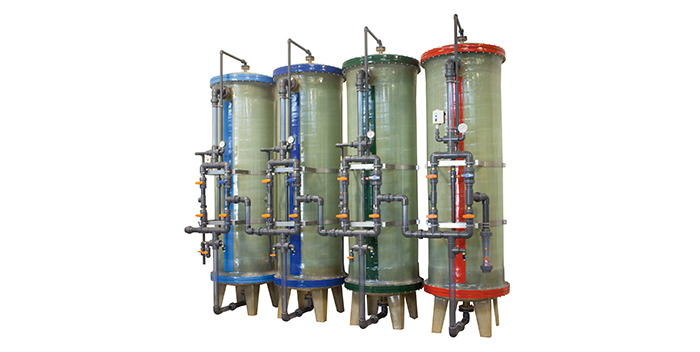Technology
More than 2000 installations in 5 continents guarantee our brand.
IONIC EXCHANGE
Based on ion exchange technology, our column equipment can turn tap water or well water into completely demineralized water.Our special columns, made in vitro-resin, are what make us different from our competitors. Apart from being ultra resistant, our columns can be dismantle in 3 parts making maintenance incredible easier to do, in cases of caking of carbon or resin.
All our machines are well equipped with security elements and the required technology so that they can work at different levels of automatization and control.
In general installations are integrated by different fiberglass columns (that contain the exchange resin) and hydraulic arms with round valves that control the water flow and the regeneration solutions.
Our company is capacitated to project and install demineralized ion exchange plants from 1000 to 3000 l/h of water.
BUILT ACCORDING TO THE REGULATIONS IN FORCE CE – MACHINE DIRECTIVES - PED
With the C&G IBERICA demineralization installations through ion exchange we can treat water from different industrial sectors and for a variety of applications.These installations are particularly beneficial in treating washing waters in galvanic lines.
In some cases, specific types of resins are used to treat water that contains Cyanide and Chromium.
SELECTIVE EXCHANGE
This same equipment is very helpful when we want to eliminate a specific metallic contamination in the water. In this case, we will have to use selective resins that will only catch that contamination.In general, there is a specific resin for each metal; some of them even work for a whole group of metals.
Other important application would be to install the equipment after a physico-chemical treatment plant, with selective metal exchange resins, so that the resins catch the metallic contamination after the treatment.
By working with generic selective resins for any type of metal, we ensured that the water will be free of metals, making time of saturation longer.
Operating scheme for galvanic water treatment
The water in the washings, depending on the type of contaminate present, its accumulated in the homogenization tank, from here, through a pump it is send to the first column (C1), that contains Granulated Active Carbon. With this column the first physico-chemical filtration is made.The active carbon, in addition to retaining the particles in suspension, possibly present in the water, also absorbs the organic matter present in the solution.
After this, water will go to the second column (C2) that contains strong cationic resin; this way it will lose the cationic charge of heavy metals, then it will go through weak anionic resin (C3), losing its load of heavy dissociated acids.
When we have cyanides or weak dissociated acids, a fourth column will be needed, (C4), that contains strong anionic resin.
Once the water is demineralized, it will return to the washing tabs it come from, this will happen until the saturation capacity of the exchange resin is reached.
When the resins saturation limit is reach, indicated by a conductivity meter installed in the exit of the columns equipment, the next step will be to start the regeneration.
This operation is made on manual mode in the backwash phase, but in automatic in the rest of the phases.
The waste produced from the regeneration and from the backwash of filters is accumulated in storage tubs in order to be depurated with the exhausted concentrates of the installation.
